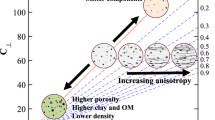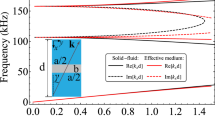Abstract
WE have demonstrated striking similarities in elastic wave propagation through rocks and single crystals in recent experiments. In particular, we find that two shear waves with displacements perpendicular to one another and with differing velocities are often propagated through rocks. This is illustrated in Fig. 1 at 5 kb pressure for samples of slate and dunite; an ultrasonic technique described by Birch1 was used. One MHz AC-cut quartz transducer generated and received the shear waves, and an electrical pulse of 50 V was used to excite the transducers. The rock samples were cylinders 2.54 cm in diameter and approximately 6 cm long.
This is a preview of subscription content, access via your institution
Access options
Subscribe to this journal
Receive 51 print issues and online access
$199.00 per year
only $3.90 per issue
Buy this article
- Purchase on Springer Link
- Instant access to full article PDF
Prices may be subject to local taxes which are calculated during checkout
Similar content being viewed by others
References
Birch, F., J. Geophys. Res., 65, 1083 (1960).
Author information
Authors and Affiliations
Rights and permissions
About this article
Cite this article
CHRISTENSEN, N. Shear Wave Propagation in Rocks. Nature 229, 549–550 (1971). https://doi.org/10.1038/229549b0
Received:
Revised:
Issue Date:
DOI: https://doi.org/10.1038/229549b0
Comments
By submitting a comment you agree to abide by our Terms and Community Guidelines. If you find something abusive or that does not comply with our terms or guidelines please flag it as inappropriate.



